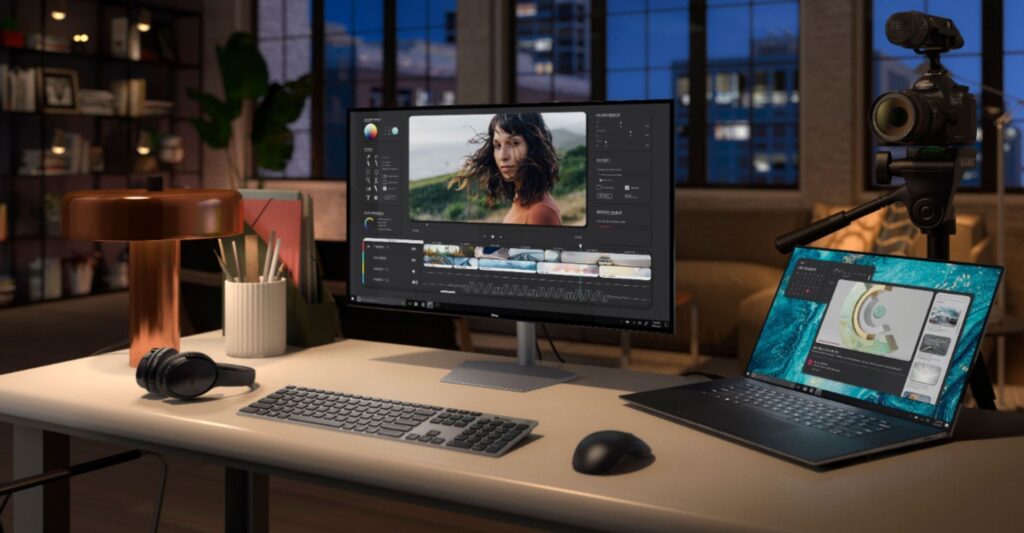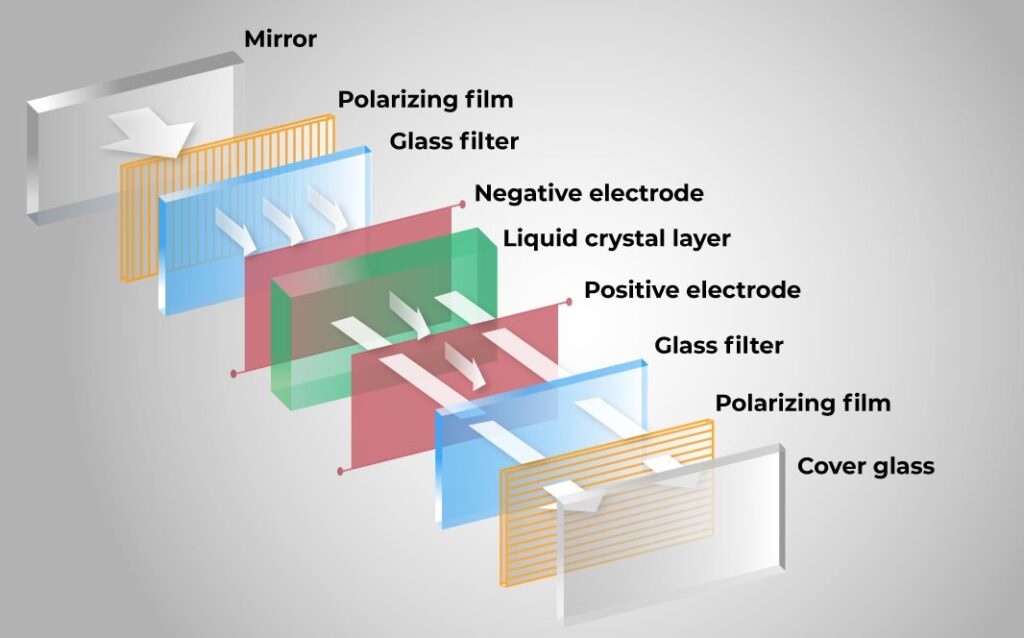
INTRODUCTION - WHAT’S A LIQUID CRYSTAL DISPLAY?
An LCD (Liquid Crystal Display) is a form of flat screen display, that relies heavily on liquid crystals to function. The LCD's design involves placing a liquid crystal cell between two parallel glass substrates, mounting a TFT (thin film transistor) on the lower substrate glass, mounting a color filter on the upper substrate glass, and modulating the signal and voltage on the TFT to control the liquid crystal molecules. Rotate the direction to decide whether or not each pixel's polarised light is emitted in order to meet the display's goals.
LCDs have a wide range of uses for both individuals and companies because they are often utilized in mobile phones, TVs, workstations, and instrument panels.
As implied by the name, liquid crystal particles make up LCDs. In most cases, a fluorescent backlight illuminates liquid crystals rather than the liquid crystals themselves emitting light.
Since their discovery in the 1800s, liquid crystals have undergone several alterations that have made them ideal for a wide range of applications.
What are THE FEATURES OF LCD?
(1) Low-voltage micro-power consumption - Throughout their lifespan, LCDs offer significant energy savings. In general, LCDs use half to two-thirds as much energy as a traditional CRT display.
(2) The appearance is small and exquisite; the thickness is only 6.5~8mm.
(3) Passive display type - Eyestrain is a frequent ailment brought on by prolonged looking at computer screens and other electronic gadgets. However, the LCD function does not cause glare, discomfort, or eye strain.
(4) The amount of displayed information is large - Information or images may be presented in a huge, clear manner since the LCD's pixels can be designed to be very tiny.
(5) Easy to colorize - The color gamut is developed to make these distinctions evident and to bring together the colors that can be used in common across devices, even if color imaging devices encompass a wide variety of equipment, such as digital cameras, scanners, displays, and printers.
(6) No electromagnetic radiation - The absence of electronic radiation is a benefit that is advantageous due to its safety for human health and ability to maintain information secrecy.
(7) Long life - The lifespan of this type of gadget is quite lengthy, but the life of the liquid crystal backlight is limited. Nevertheless, the backlight component may be changed. Although they don't normally live forever, LCDs have a longer lifespan than other display technologies. An average LCD might operate for up to 60,000 hours. That might convert into 20 or more years of utilization, depending on how regularly you use it.
THE HISTORY OF LIQUID CRYSTAL DISPLAY (LCD) AND ITS INDUSTRY
The liquid-crystal display was created in 1964 at RCA Laboratories in Princeton, New Jersey. The twisted-nematic (TN) mode of functioning, which was developed in 1970, was the key to LCD's initial commercial success. Small-size LCD screens were provided by LCD producers for use in portable items like digital watches and pocket calculators. A TFT (thin-film-transistor) array was used by Sharp Corporation in 1988 to show a 14-inch active-matrix full-color full-motion display. Japan established a real LCD industry after observing this. First, personal computers and later television receivers received large-size screens. The industry relocated to Korea and Taiwan in the latter part of the 1990s.
WORKING – HOW DOES AN LCD WORK?

The liquid crystal that makes up an LCD is encased between two sheets of polarised glass (also known as a substrate), along with a backlight.
Beams known as polarised light are formed as a result of the process of polarisation, which limits the vibration of light waves to a single plane.
Liquid crystals require an external light source to function because they cannot create light on their own. Sets of polarised glass with liquid crystal materials sandwiched in between them make up an LCD screen. Whenever an electrical current is applied to the liquid crystal molecules and outside light passes through one of the polarised glasses, the liquid crystal molecules arrange themselves in such a way that polarised light moves from the first layer to the second polarised glass. This causes an image to show up on the display.
Electrical currents cause the liquid crystal molecules in the first layer of glass to shift and align, allowing the backlight to flow through. As a result, only particular intensities of polarised light (basically light waves) may reach the second substrate.
The RGB (Red, Green, and Blue) pixels that are crammed into the display use this light as their light source to combine to produce the image that is displayed on the screen.
However, there are other considerations than LCD technology that affect the image's quality.
What are the TYPES OF LIQUID CRYSTAL displays?
The types of displays that we are going to discuss under this head are:
The TN (Twisted Nematic) LCD may be produced most commonly and is utilized in a variety of industries for different types of displays. Due to its low cost & rapid reaction time compared to other displays, gamers utilize these screens the most frequently. The primary drawback of these displays is their poor quality, which also extends to their partial contrast ratios, viewing angles, and color reproduction. However, these tools are enough for daily tasks.
Due to some distinctive key features that TN displays offer, TN LCDs continue to have a loyal user base even as other screen types gain in popularity. One difference between TN LCDs and other TFT LCDs is their quick response and refresh rates.
Comparing IPS to TN displays, IPS LCD performs better in terms of contrast, brightness, viewing angles, and color representation. No matter the viewing angle, images on the screen maintain their clarity without being washed out or distorted. As a result, viewers are not restricted to looking at the display from a front-center position and may watch material on the screen from practically any angle.
IPS panels enable the creation of vivid, precise, and crisp pictures that can be seen from practically any angle.
Because they offer superior image quality, greater viewing angles, bright color accuracy, and difference, IPS LCDs are regarded as the best LCDs. The majority of users of these displays are graphic artists, and in certain other contexts, LCDs require the highest possible standards for picture and color reproduction.
Between Twisted Nematic and In-Plane Switching Panel technologies, the vertical alignment (VA) panels can be placed anywhere in the middle. In comparison to TN-type displays, these panels have greater quality characteristics and the best viewing angles and color reproduction. The reaction time of these panels is quick. These, however, are far more practical and suitable for everyday usage.
What are the APPLICATIONS OF AN LCD?
When it comes to the use and applications of LCDs, many different items include:

TVs and Monitors
Liquid crystal display (LCD) panels have gained popularity in the high-definition television industry because of technological advancements. Large flat panel LCD or Plasma displays are increasingly replacing traditional Cathode Ray Tube (CRT) televisions in the market as broadcasting technology advances from analog to digital television.
Although liquid crystal display television (LCD TV) is a new invention, other home furnishings like digital readouts, microwave timers, and personal computers often use liquid crystal displays for many years.
LCD projectors are available for organizations to use to show video, photos, or data like how the old overhead projector previously did, thus the technology is not limited to giant flat-screen TVs.
The most common computer display device, an LCD computer monitor, is another area where LCD technology is used. Customers frequently choose LCD monitors because of how little room the flat panel screen takes up.
The LCD has taken the role of the large computer screen, and all new computers now come with one as standard equipment. The benefits of purchasing an LCD monitor go beyond just its size and include the money you'll save because it uses so little of your power source to operate.
The viewing experience on liquid crystal display television (LCD TV) has significantly improved.
Camera
Images are shown on LCDs in digital cameras. It makes it simpler for you to determine if you got the shot just right or whether you need to try again. The LCD may be used as a live perspective, to study the images, and to provide menu options.
Among the LCDs' further uses are:
Industrial Applications
Over the past several years, the usage of digital displays has multiplied throughout multiple networks and sectors. The variety of uses for digital panels is limitless, from industrial LCD monitors to maritime and military activities. The Liquid Crystal Displays are perfect for indoor and outdoor applications in calm and challenging settings because of their distinctive features like brightness adjustment and infrared illumination.
Many indoor businesses and applications employ LCDs and industrial touch panels. For instance, they are utilized in industrial manufacturing facilities, arenas, stadiums, inside automobiles, and during the preparation and filling of food and beverages. They are also used at galleries and museums, as well as at kiosks and ticket booths. Surgical units, hospital carts, and telehealth systems all make use of LCDs as medical monitors.
PROS AND CONS OF THE LIQUID CRYSTAL DISPLAY (LCD)
The last few decades have seen significant advancements in electronic display technology. Cathode ray tubes (CRT) are no longer the industry norm. Nowadays, liquid-crystal display (LCD) technology is widely used in electronic displays like TVs, computer screens, industries, and smartphones. Let's examine the benefits and drawbacks of LCD technology in more detail.
PROS:
CONS:
CONCLUSION
The evolution of electronic displays has a direct relationship to the current history of liquid crystals.
Liquid-crystal displays (LCDs), have liquid organic material pixels and these days, LCDs are utilized everywhere and almost constantly. They are utilized in buildings like houses, workplaces, schools, factories, and even cars.
The blog we hope, "The Ultimate Guide to Liquid Crystal Display," should have been able to provide you with as much information as possible on LCDs.